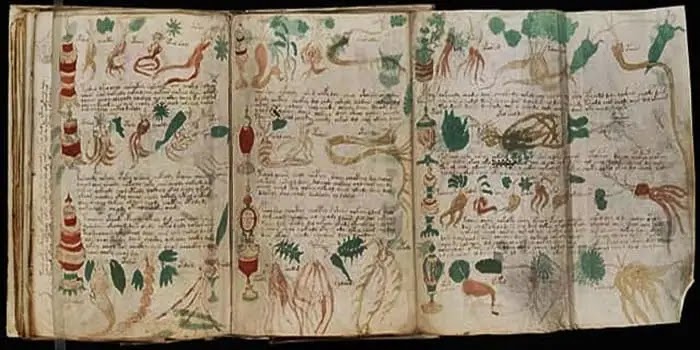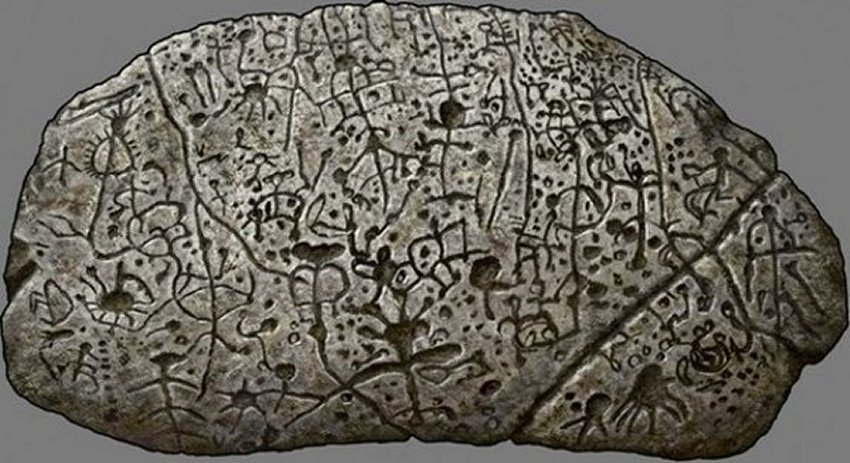By Peter Pavarini

Mankind has been scribbling on rocks for at least 50,000 years[i]. The meaning of the markings, signs and illustrations left by our ancestors upon cave walls and other surfaces remained uncertain until, around 3400 B.C., the Sumerians of Mesopotamia developed a cuneiform script we recognize today as a written language.
A petroglyph is defined as an image created when the surface of a rock is partially removed by incising or carving to create a type of rock art. Petroglyphs have been found worldwide and are generally associated with prehistoric or nonliterate cultures. In the United States, they are most concentrated in the southwestern states although a fair number of them are found east of the Mississippi.[ii] Before the invention of papyrus, parchment and paper – not to mention any of today’s digital formats – scratching one’s thoughts or observations upon a rock was probably the best way to send a message that would outlast its creator.
Soapstone is a metamorphic form of talc that can be easily carved and fashioned into a number of useful items such as cooking bowls, smoking pipes and gravestones. Although not common, it is found throughout the world and for millennia has been used by primitive people as a preferred medium for their rock art.
The Petroglyph in My Backyard
For the past 19 years, I’ve owned a home in the Blue Ridge Mountains of North Carolina not far from an extraordinary petroglyph known as Judaculla Rock. This curvilinear-shaped outcropping of blue soapstone measures 26 square feet in size and sits in a verdant pasture near the Nantahala National Forest. The 15-acre site containing Judaculla Rock was recently placed on the U.S. Register of Historic Places and has begun to receive the recognition it richly deserves.
What distinguishes Judaculla Rock is not only its isolated location[iii], but also the incredible number and variety of etchings and carvings that completely cover its exposed surface. Unlike any other petroglyph I’ve visited in the U.S., none of the 1548 etchings on the rock’s surface are recognizable figures or symbols. Archaeologists have classified the rock’s carvings into ambiguous categories such as cup marks, bowl-shaped depressions, rills, concentric ring designs, and claw-like imprints. Anyone who goes to the site expecting to see familiar depictions of animals, hunters, shamans and the like will be sorely disappointed. Indeed, most travel guides simply describe the carvings on Judaculla Rock as “undecipherable.”[iv]
Deciphering the Undecipherable
But is this rock really enigmatic? Egyptian hieroglyphics were equally mysterious until the discovery of the Rosetta Stone provided a way to decipher these ancient scripts previously considered unreadable. Why would Judaculla Rock’s scribes have spent countless hours engraving its surface unless they wanted to leave some kind of message for those who came after them?
Even manuscripts from the post-literate era are occasionally deemed to be undecipherable. The Voynich Manuscript, the 15th century codex housed in Yale University’s Beinecke Rare Book and Manuscript Collection, has baffled experts since it was rediscovered in 1912. Numerous efforts to unlock the meaning of its one-of-a-kind text and illustrations of otherworldly plants, unfamiliar constellations and naked women swimming through fantastical tubes and green baths have all proven fruitless.[v]

Of the many things which drew me and my family to Western North Carolina is its rich cultural heritage. Anchored by the offbeat city of Asheville, the state’s western panhandle is a melting pot of cultures ranging from back-to-nature survivalists, entrepreneurial brew meisters, Bible Belt traditionalists, to New Age cultists. Underlying all of this is a rich tapestry of tribal and folk culture.
The Cherokee Legend of Judaculla
Conventional thinking attributes both the name “Judaculla” and the legend surrounding the rock to the Cherokee people as they were known at the point of European contact. Although there’s no evidence that Cherokees previously recorded their history in stone etchings, the tribe’s oral tradition claims that the rock was named after a seven-fingered giant whose voice boomed like thunder and whose arrows became lightning when fired from his mighty bow. The word “Judaculla” is a reference to the giant’s slanted eyes, but he apparently wasn’t a one-off mutant. Cherokee legend also claims that the tribe peacefully co-existed with a race of giants until they returned to a place in the direction of “where the sun goes down”. These giants were at least twice as tall as common men, but possibly even taller since legend has it that Judaculla could see his reflection in Looking Glass Rock, an 869-foot-tall pluton monolith along the Blue Ridge Parkway.
Giants in folklore[vi], both Native and Western, are rather common. Take Jack and the Beanstalk, for example. What sets Judaculla’s story apart from other legends about giants was his fancy for a particular Cherokee maiden he wanted as his bride. This did not sit well with tribal leaders who insisted that they get something in return for the young woman. As a compromise, Judaculla promised to leave detailed instructions on how brave and faithful Cherokees could enter the spirit world after their deaths. Legend says that those instructions were then etched upon Judaculla Rock.
Looking for Meaning Beyond the Legend
And that’s all some folks wish to know about the rock and its cryptic markings. Local authorities, archaeological and historical experts, even the Eastern Band of the Cherokee Nation seem uninterested in pursuing the matter any further. [vii] Why is that? It’s not as though Judaculla Rock has been the Disney World of rock art or other lucrative tourist destination. Aside from one small sign along NC Route 107, it would be very easy to drive by this lowly point of interest.
What has changed in recent years is the internet’s growing interest in Judaculla Rock. A Google search of Judaculla Rock now produces nearly 63,700 search results. As a part-time western North Carolinian, I was surprised to find Judaculla Rock listed among the most significant archaeological sites in North America, along with Colorado’s Mesa Verde, New Mexico’s Chaco Canyon, Ohio’s Great Serpent Mound in Ohio, and even the 22,000-year-old fossilized human footprints in White Sands National Park.[viii]
But equally surprising is the fact that, despite the public’s interest in Judaculla Rock, the site has never been thoroughly studied by archaeologists, geologists or other experts. Without the radiocarbon dating done on similar rock art sites, it’s anyone’s guess how old these etchings really are.[ix] Reportedly, there are two other petroglyph-covered rocks in the immediate vicinity that were supposedly “buried in a mining accident” some years ago. It seems odd that no one has bothered to exhume those relics or anything else that might shed light on this mystery. There’s also a large vein of copper that runs through the site as well as other mineral deposits that create a detectable electromagnetic force around the rock. Had those geological anomalies been enough to attract ancient people to this location?
The few investigators who have taken the time to analyze the rock’s etchings have determined they are not entirely unique. Comparable etchings have been found in other places, some as far away as Scotland. Other researchers have found that many of the etchings are strangely similar to microbes that can only be seen through a microscope.[x] Another theory states that the engraved patterns on Judaculla Rock are really a star map, a guide to interstellar travel. Lastly, the etchings could be visual aids meant to help a storyteller recall an exceedingly unusual plasma discharge.[xi]

Rejecting the Suppression of Alternative Thinking
Whatever the truth might be, suppressing non-conformist views about the origin of Judaculla Rock’s etchings doesn’t strike me as particularly enlightened. Whenever humans faced mysteries in the past that couldn’t be explained by existing knowledge, it fell to outliers like Galileo and Copernicus to advance the state of scientific understanding. There are certainly people alive today who by unconventional means may be able to unlock the “code” surrounding this mysterious artifact. To dismiss their alternative views simply because they might be a threat to the status quo is the same orthodoxy that impeded scientific advancement in the past.
Sometimes a rock is just a rock. Other times it’s the touchstone that unleashes our imagination and creative potential.
[i] See www.rockartdatabase.com
[ii] The most important petroglyphs in the eastern U.S. are recognized by the Eastern States Rock Art Association, www.esrara.org. The two sites in Ohio, Leo Petroglyphs and Inscription Rock, are modest in comparison to Judaculla Rock which is the largest and possibly oldest example east of the Mississippi.
[iii] Judaculla Rock is situated within the ancestral homeland of the Cherokee Nation. Although the site is now publicly-owned, it has been protected by a local family which farmed this area for over 100 years. The Eastern Cherokee Indian Reservation lies approximately 14 miles north of the rock’s location.
[iv] See, e.g., https://www.ancient-origins.net/unexplained-phenomena/judaculla-rock
[v] https://beinecke.library.yale.edu/collections/highlights/voynivh-manuscript
[vi] There is also disputed fossil evidence of over-sized humanoids. The skeletal remains of such creatures have been found in Lucerne, Switzerland (1577), Albany, N.Y. (1705) and most recently in the Ozarks. Most of these reports seem derived from Biblical accounts of giants co-existing with the offspring of Adam and Eve (Genesis 6:4, Numbers 13:32-33). Called “Nephilim”, they were the heroes of old who lived in Canaan when Moses sent his men to explore the Promised Land. When the Bible was translated into the Cherokee language, the English-speaking translators used the word “Judaculla” in place of Goliath.
[vii] W. Kuhner, “The Indecipherable Rock Art of Judaculla Means Different Things to Different People”, www.medium.com (2017).
[viii] www.loveexploring.com/gallerylist/157818/these-historic-american-discoveries-remain-steeped-in-mystery ; also Ten Puzzling Unsolved Mysteries in the World, and Top Ten Mysterious Rock Art Sites From the Ancient World.
[ix] Most archaeologists say the majority of the etchings were made from 1400 B.C. to 200 A.D. – known as the late Archaic Era. This, however, is based on secondary evidence of how natives were then in the process of replacing their hunter-gatherer lifestyle with a more sedentary agricultural economy. A few archaeologists believe Judaculla Rock was actually inscribed at the end of the Last Ice Age, as much as 12,000 years ago. At the other end of the spectrum, some experts claim that the etchings are only about 300 years old.
[x] Judaculla Rock (freecharm.com)
[xi] Plasma physicist Anthony Peratt has noted that many Native American petroglyphs appear uncannily like the Birkeland currents in plasmas. Judaculla Rock contains at least one such petroglyph.

Be First to Comment